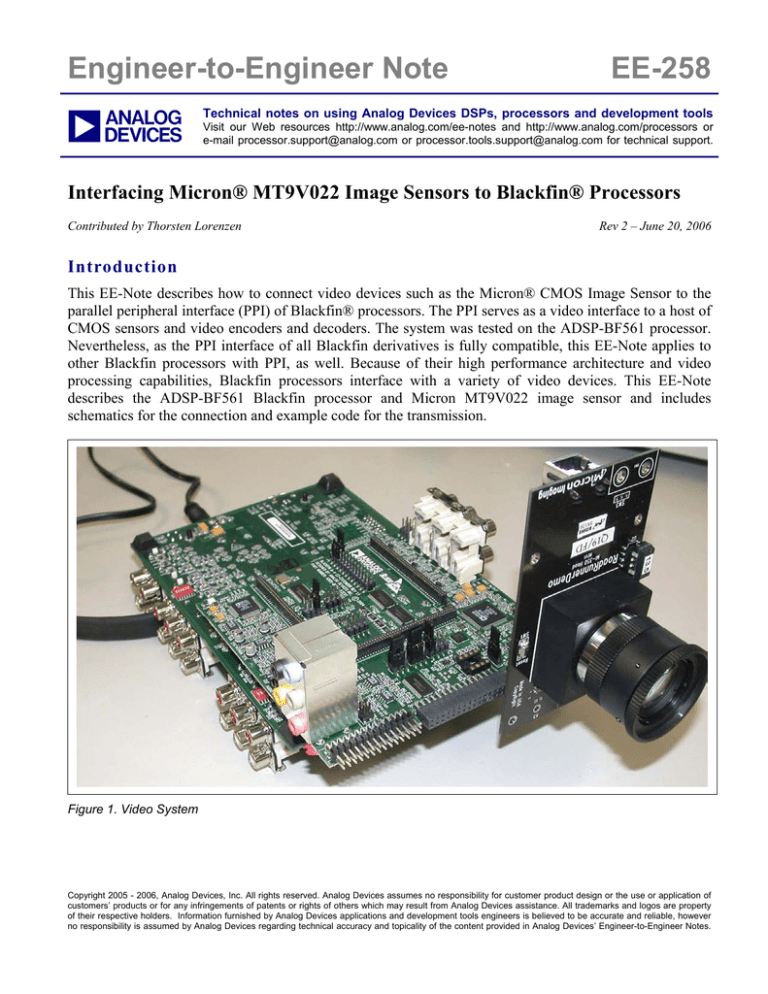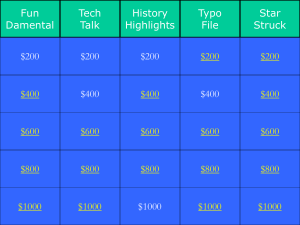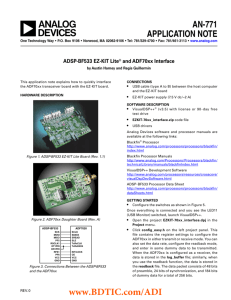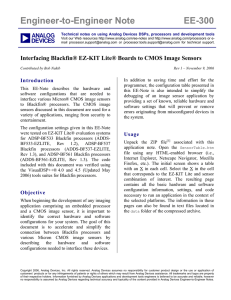a Engineer-to-Engineer Note EE-258
advertisement

Engineer-to-Engineer Note
a
EE-258
Technical notes on using Analog Devices DSPs, processors and development tools
Visit our Web resources http://www.analog.com/ee-notes and http://www.analog.com/processors or
e-mail processor.support@analog.com or processor.tools.support@analog.com for technical support.
Interfacing Micron® MT9V022 Image Sensors to Blackfin® Processors
Contributed by Thorsten Lorenzen
Rev 2 – June 20, 2006
Introduction
This EE-Note describes how to connect video devices such as the Micron® CMOS Image Sensor to the
parallel peripheral interface (PPI) of Blackfin® processors. The PPI serves as a video interface to a host of
CMOS sensors and video encoders and decoders. The system was tested on the ADSP-BF561 processor.
Nevertheless, as the PPI interface of all Blackfin derivatives is fully compatible, this EE-Note applies to
other Blackfin processors with PPI, as well. Because of their high performance architecture and video
processing capabilities, Blackfin processors interface with a variety of video devices. This EE-Note
describes the ADSP-BF561 Blackfin processor and Micron MT9V022 image sensor and includes
schematics for the connection and example code for the transmission.
Figure 1. Video System
Copyright 2005 - 2006, Analog Devices, Inc. All rights reserved. Analog Devices assumes no responsibility for customer product design or the use or application of
customers’ products or for any infringements of patents or rights of others which may result from Analog Devices assistance. All trademarks and logos are property
of their respective holders. Information furnished by Analog Devices applications and development tools engineers is believed to be accurate and reliable, however
no responsibility is assumed by Analog Devices regarding technical accuracy and topicality of the content provided in Analog Devices’ Engineer-to-Engineer Notes.
a
Micron MT9V022 Digital Image Sensor
The Micron MT9V022 is a wide-VGA, 1/3-inch optical format, CMOS digital image sensor with global
shutter and high dynamic range operation up to 110 dB. It has been designed specifically to support the
demanding interior and exterior automotive imaging needs, which makes this part ideal for a wide variety
of imaging applications in real-world environments. The MT9V022 features DigitalClarity™,-Micron’s
breakthrough, low-noise CMOS imaging technology that achieves CCD image quality (based on signalto-noise ratio and low-light sensitivity) while maintaining the inherent size, cost, and integration
advantages of CMOS. The active imaging array format is 752H x 480V (pixels). It incorporates
sophisticated camera functions on-chip such as binning 2x2 and 4x4 to improve sensitivity. For more
information, refer to the Micron Web site [4] (see section References at the end of this EE-Note).
L
This EE-Note uses the MT9V022 as an example to explain the detailed interface between a digital
image sensor and a Blackfin processor. Derivatives of this sensor, including Micron Megapixel
products that meet the video port specification of Blackfin processors, also connect directly to the
Blackfin video port.
MT9V022 Output Format
The MT9V022 has a pixel array of 782 columns by 492 rows. The leftmost 26 columns and the top eight
rows of pixels are optically black and can be used to monitor the black level.
The MT9V022 image data can be read in progressive scan mode or interlaced scan mode. Valid image
data is surrounded by horizontal and vertical blanking, as shown in Figure 3. The amount of horizontal
and vertical blanking is programmable through a two-wire interface. By default, LINE_VALID is HIGH
during the shaded region of Figure 3. The data output of the MT9V022 is synchronized with the PIXCLK
output (Figure 2). When LINE_VALID is HIGH, one 8/10-bit pixel datum is output every PIXCLK period as
shown in Figure 2. In this document, the default settings have been specified as follows:
8/10-bit data output
Data is valid on the rising edge of PIXCLK
LINE_VALID (HSYNC) active high
FRAME_VALID (VSYNC) active high
No FIELD signal is required
Figure 2. Output Data Timing
Interfacing Micron® MT9V022 Image Sensors to Blackfin® Processors (EE-258)
Page 2 of 18
a
Figure 3. Image Read Out
In addition to the LINE_VALID signal, the FRAME_VALID signal indicates the start of a new frame. By
default, the FRAME_VALID signal is HIGH (Figure 4) during the phase of valid image data as well as
horizontal blanking as shown outside the vertical blanking interval VBI in Figure 3.
Figure 4. Frame Valid Timing
Connecting to the MT9V022
Micron offers head boards (e.g., Head350/360) for MT0V022 evaluation. Interface the Micron head board
to the ADSP-BF561 EZ-KIT Lite® evaluation system board via a Blackfin A-V EZ-Extender board (see
page 5). The Micron head board links all the required signals for video transmission and sensor
programming to its connector (Figure 5). Refer to the ADSP-BF561 EZ-KIT Lite Evaluation System
Manual [6] and the Blackfin A-V EZ-Extender Manual [7] for settings and connections. Figure 14 shows the
schematic of the Blackfin A-V EZ-Extender board.
Figure 5. Micron Head Board Main Connector
Interfacing Micron® MT9V022 Image Sensors to Blackfin® Processors (EE-258)
Page 3 of 18
a
Blackfin Processor Video Port Interface
Due to their multimedia processing capabilities, Blackfin processors are equipped with a minimum of one
Parallel Peripheral Interface (PPI). The ADSP-BF561 Blackfin processor provides two of these interfaces.
The PPI is a half-duplex, bidirectional port that accommodates up to 16 bits of data. It has a dedicated
clock pin, three frame sync pins, and eight dedicated data pins. Up to eight additional data pins are
available by reconfiguring other pins (multiplexed pins). The highest system throughput is achieved with
8-bit data, since two 8-bit data samples can be packed as a single 16-bit word. In this case, the earlier
sample is placed in the eight least significant bits (LSBs). The PPIx_CLK pin can accept an external clock
input. It cannot source a clock internally.
The PPI supports two major categories of modes. In ITU-BT656 mode, only the clock input (PPI_CLK)
and the parallel data bus are available. In this mode, the PPI recognizes the start of transmission by
scanning the data bus for the embedded preamble. When the preamble occurs with the Start of Frame bits
set, the PPI starts its transmission. In general-purpose (GP) mode, up to three additional pins can be used
to support devices that are not compatible with the ITU-BT656 standard. In this mode, the horizontal
synchronization signal (HSYNC), vertical synchronization signal (YSYNC), and the field indicator (FIELD)
are used to detect the start of a transmission. For the example in this EE-Note, the PPI is configured to run
in GP input mode with two external frame syncs.
L
The FIELD signal is not used in this example system.
Ensure that this pin is pulled to ground.
The PPI has a very flexible interface and can be configured to support many other devices. For example,
in GP input mode the polarity of the clock can be inverted (via the POLC bit in the PPI_CONTROL register)
to latch data at the rising edge (POLC = 0) or at the falling edge (POLC = 1). In addition, the polarity of
the frame sync signals (HSYNC, VSYNC) can be inverted (via the POLS bit in the PPI_CONTROL register).
When POLS is cleared (POLS = 0), the HSYNC and VSYNC signals are treated as active high. When POLS is
set to one (POLS = 1), they are active low. As discussed earlier, configuring the PPI data bus to be eight
bits wide results in the best efficiency because any DMA (programmed to be 16 bits wide) data fetch to
the PPI can take two samples. If required for better quality, the PPI bus can be extended to up to 16-bits
successively. In this case, a single sample will be transferred at a single DMA fetch. Still a maximum of
sixty-six million samples per second (66 MS/s) can be achieved while the DMA bus bandwidth is even
higher. Derivative processors equipped with an internal 32-bit bus structure (such as the ADSP-BF561)
can transfer two 16-bit samples at a time instead. Another important feature is the PPI delay count register
(PPI_DELAY) (see Figure 6), which contains the number of PPI_CLK cycles of delay after assertion of
PPI_FS1 (HSYNC) before start of when read data is read in.
In general, the PPI can be considered to be a static state machine driven by the PPI clock (PPI_CLK).
Whenever the PPI clock is provided, the state machine is able to latch data and/or frame syncs. After
being enabled when programmed to 2 or 3 frame sync input mode, it remains in an idle state until
assertion of vertical frame sync (VSYNC PPI_FS2) is followed by the assertion of horizontal frame sync
(HSYNC PPI_FS1) while the signal FIELD is low. The PPI starts transmission and stops when it has fetched
the number of samples programmed in the PPI count register (PPI_COUNT). If it is limited to a number of
samples, the transmission stops after the counter expires (Figure 6). The transmission will be reactivated
after assertion of the horizontal frame sync due to the next active video line. This way it can be ensured
that just the active video image is loaded without blanking. Figure 6 shows the characteristic discussed
Interfacing Micron® MT9V022 Image Sensors to Blackfin® Processors (EE-258)
Page 4 of 18
a
here. When the state machine detects the assertion of either frame sync, it latches the state. Therefore,
PPI_FS1 and PPI_FS2 do not need to remain active during transmission (dotted lines). As explained
earlier, when the PPI_COUNT expires the transmission stops.
Figure 6. PPI Input Start Condition
ADSP-BF561 EZ-KIT Lite Evaluation System and Daughter Boards
The ADSP-BF561 EZ-KIT Lite evaluation system includes an ADSP-BF561 processor desktop evaluation
board and an evaluation suite of the VisualDSP++® development and debugging environment with a
C/C++ compiler, assembler, and linker. It also includes sample processor application programs, a CEapproved power supply, and a USB cable. Analog Devices offers daughter boards that extend the
capabilities of the EZ-KIT Lite board.
The ADSP-BF561 EZ-KIT Lite board provides developers with a cost-effective method for initial
evaluation of the ADSP-BF561 Blackfin processor for audio and video applications via a USB-based PChosted tool set. Evaluation of analog audio applications is achieved through the board's AD1836 multichannel 96 kHz audio codec. Utilize the board's ADV7183A advanced 10-bit video decoder and the
ADV7179 NTSC/PAL video encoder to evaluate video applications such as simultaneous input and output
video processing enabled by the dual-core architecture of the ADSP-BF561 processor. With this EZ-KIT
Lite evaluation system, you can learn about Analog Devices ADSP-BF561 hardware and software
development and prototype applications quickly.
Interfacing Micron® MT9V022 Image Sensors to Blackfin® Processors (EE-258)
Page 5 of 18
a
Part Number: ADDS-BF561-EZLITE
Part Number: ADDS-BF-AV-EZEXT
Figure 7. ADSP-BF561 EZ-KIT Lite Board
Figure 8. Blackfin A-V EZ-Extender Board
The Blackfin A-V EZ-Extender (daughter board) allows developers to connect the Parallel Peripheral
Interface (PPI) on Blackfin processors to the Analog Devices standard PAL/NTSC video decoder and
encoder (ADV7183 and ADV7179). In addition, you can connect digital image sensor boards like the
Micron head board (MI350_head_V01) discussed in this document and an external LCD display via four
different connectors.
L
For more information on Analog Devices tools, refer to the following web page.
http://www.analog.com/processors/productsDatasheets/evaluationKits.html
Interfacing Micron® MT9V022 Image Sensors to Blackfin® Processors (EE-258)
Page 6 of 18
a
Blackfin Processor-to-Image-Sensor Interface
Figure 9 shows the general connections from the sensor board to the PPI. In cases where video boards do
not offer a clock, use an external oscillator or a Blackfin PWM timer. The Blackfin PPI interface offers all
the signal inputs to typical image sensors. It’s very easy to interconnect those devices, and no extra glue
logic is required.
L
Because the Field signal is not used in this system, the field pin (PPIx_FS3) must be connected to
ground. Please check your hardware as this may need to be done manually.
Figure 9. High-Level Interface Scheme
As mentioned earlier, Micron offers a head board unit that can be plugged into the Blackfin A-V EZExtender board via connector J6. The MI350_head_Vxx consists of an image sensor, oscillator, power
regulator, and a standard connector (P1). Figure 14 in this document's Appendix shows the schematic of
the head unit. In turn, the Blackfin A-V EZ-Extender board must be plugged into the ADSP-BF561 EZKIT Lite board. Figure 1 is a photograph of the system, showing all the boards connected together. To
ensure proper operation, set switches and install jumpers according to Table 1 and Table 2.
SW2
6 > off. Keeps the video decoder from driving PPI0.
SW3
1 > off, 2 = off. Non flash boot ensures that PPI0 does not drive against the image sensor output.
SW5
2 > off. Links the external sourced clock to PPI0.
Table 1. ADSP-BF561 EZ-KIT Lite Settings (All other switches should remain in their default state.)
JP1
Not applicable. This is not relevant to this application.
JP2
2-3. Puts 5V to the image board. Note that boards other than Micron may require a 3V supply (1-2).
JP3
3-5, 4-6. I2C connection. Connections to the ADSP-BF537 EZ-KIT Lite would require different settings (5-7, 6-8).
JP4
7-8. Links the image sensor output clock to PPI0. An external clock source may be required for image sensors other
than Micron (such as Kodak image sensors). Therefore, a jumper from 1-2 supports those devices.
JP5
1-2. Enables the PPI 16-bit bus. In case to run an image sensor in resolutions higher than eight bit.
JP6
3-5, 4-6. Controls the direction of FS1 (HSYNC) and FS2 (VSYNC) so that the image sensor signals drive PPI0
JP7
Not applicable. This is not relevant to this application.
JP8
Not applicable. This is not relevant to this application.
JP9
3-5. Forces the reset per reset button. 4-6 to drive the sensor data bus into PPI0 (direction control).
Table 2. Blackfin A-V EZ-Extender Jumper Settings (Other jumpers need not be populated.)
Interfacing Micron® MT9V022 Image Sensors to Blackfin® Processors (EE-258)
Page 7 of 18
a
Video Channel Configuration (PPI → DMA → Memory)
This section focuses on different methods to set up the data stream from PPI to memory via a DMA
channel.
Multiple peripheral interfaces must be chained (PPI → DMA channel → EBIU → SDRAM) to build up a
video channel. The PPI is linked to a DMA channel via the DMAx_PERIPHERAL_MAP register. Through the
DMA Start Address register, the DMA channel points to SDRAM memory space and is linked to the
External Bus Interface Unit (EBIU). The block diagram in Figure 10 shows when the PPI has been started
to fill its FIFO. The FIFO overflows unless the DMA has been set up beforehand to empty the FIFO over
the DAB bus. Therefore, the PPI requests the DMA controller when the very first sample has been stored
into the PPI FIFO. This prevents the PPI FIFO from overflowing in case the DMA can’t service the
request due to the DMA bus being taken by another DMA channel. In this case, 15 stages are available
within the FIFO to make those delays possible. Through its DMA FIFO (not shown), the DMA transmits
the data to the EBIU.
Multiple methods are available to set up a transmission to satisfy different requirements. The method that
results in the highest performance might not always provide the required functionality. For instance, the
ADSP-BF561 offers 32-bit buses internally to transfer data from the PPI to memory. Therefore, when the
DMA is configured to a bus width of 32-bits (WDSIZE field in DMAx_y_CONFIG register), it fetches two 16bit words from the PPI FIFO for any access. This results in the highest performance. Additionally, when
the packing enable bit (PACK_EN) in the PPI Control register is set, the PPI packs each second byte to a 16bit word within the PPI FIFO. Note that packing is available at a maximum bus width of eight bits.
However, a PPI bus width higher than 8-bit packing does not have any effect. For sensors with resolutions
higher than eight bits, any sample will be treated as 16 bits wide. Furthermore, when the DMA channel
uses its 32-bit bus, byte-aligned addresses cannot be targeted. The address needs to be 32-bit aligned. 16bit addresses (e.g., 0x0000 0002) can be targeted only when the DMA channel is set to the 16-bit bus
width; byte addresses can be targeted only when the channel is set to the 8-bit bus width (0x0000 0001).
Ensure that you choose a proper setup.
Blackfin Processor
Figure 10.Video Input Block Diagram
Interfacing Micron® MT9V022 Image Sensors to Blackfin® Processors (EE-258)
Page 8 of 18
a
Debugging Video Applications with VisualDSP++ Tools
Suitable for many multimedia applications, Blackfin processors are supported by many debugging utilities
available in the VisualDSP++ tools. Today, VisualDSP++ provides an Image Viewer tool that allows you
to display video images stored in internal or external memory. By selecting the image width, height, and
data format in which it is stored, the Image Viewer will download the data and display it as a regular
image. Without any additional tools, images can be rendered using VisualDSP++. Figure 11 shows how
an image is configured via the Image Configuration dialog box. The PPI port is capable of allowing the
entire video stream to pass (active video plus blanking) or selectively streaming either active video or
blanking data. Therefore, the Width and Height settings can be modified to display the image in its proper
form. These settings also need to be modified to display different image sizes. The Start address field
points to the starting location of where the image is located in memory, whereas Pixel format provides a
collection of supported data formats. Additionally, images can be modified (gamma adjust, rotation, and
flipping) and stored on hard disk in JPG and BMP formats.
Figure 11. VisualDSP++ 4.0 Image Viewer
Another powerful tool that helps you build and debug image processing applications is the plotting tool.
Use the plot capabilities in VisualDSP++ to display the results of an image being processed by certain
algorithms in different views. For example, running the Hough transform over an image will result in
many vectors stored in the Hough space storage. To investigate which vector points to a possible line in
the image, view a spectrogram plot and a waterfall plot. Visually, the spectrogram plot shows the vectors
and its importance in terms of the number of pixels that refer to this vector. For object recognition
algorithms, spectrogram plots can be used to find the location of objects with the highest correlation to an
object of interest. The spectrogram plot shows memory locations in two-dimensions (2-D); waterfall plots
show the same locations in 3-D. Therefore, waterfall plots display the same results in the spatial domain.
Interfacing Micron® MT9V022 Image Sensors to Blackfin® Processors (EE-258)
Page 9 of 18
a
For details, refer to the VisualDSP++ User's Guide
[5]
or VisualDSP++ online Help.
Figure 12. VisualDSP++ Spectrogram Plot
Figure 13. VisualDSP++ Waterfall Plot
Interfacing Micron® MT9V022 Image Sensors to Blackfin® Processors (EE-258)
Page 10 of 18
a
Coding Example
The following section discusses the file main.c as shown in Listing 4. The file main.c shows how to
program the Blackfin processor to receive proper images.
First, an array (VideoInputFrame) must be defined to store the received image. Since the active image
contains 345,600 bytes (720x480 8-bit gray scale pixels) the array must be stored in external memory (i.e.,
SDRAM). This can be done with the section directive. In this case, the array is located in the
sdram_data input section, which is defined in the file adsp-bf561_C.ldf. Refer to:
C:\Program Files\Analog Devices\VisualDSP 3.5 16-Bit\Blackfin\ldf\adsp-bf561_C.ldf
section ("sdram_data")
volatile unsigned short VideoInputFrame[LINES_PER_FRAME][PIXEL_PER_LINE/2];
Listing 1. Array Definition
L
The image array is defined as unsigned short (16-bit values). Therefore, each line in the array
must be half the size of the number of pixels provided by the sensor (8 bits wide).
The MI350_init()function within main.c programs the sensor via the I2C protocol. Because the ADSPBF561 Blackfin processor does not have an on-chip I2C interface, two of the programmable flags are used
to emulate this function (GPIOs). Due to license restrictions, the I2C routine is not available here. Contact
processor.support@analog.com or processor.europe@analog.com for a license agreement, or search the Internet with
dedicated keywords.
void main() {
usDestAddr = &VideoInputFrame[0][0];
// init the pointer with the start
// addr of the array
// initialise SDRAM
InitSDRAM();
// initialise Micron Sensor
MI350_init();
// Calls an I2C function to program the sensor
VideoSensorFrameCapture ( (void*) usDestAddr );
// function call to config
while(1);
};
Listing 2. main() Function
Finally, the VideoSensorFrameCapture()function is called to set up the data path (Listing 3).
In this example, channel 0 of DMA Controller 1 has been chosen to transmit the video stream received by
the PPI interface. Since the DMA channel is set up for 2-D mode, two DMA counters (X and Y) must be
initialized. The X count specifies the number of transmissions per video line, and the Y count specifies the
number of lines to be transmitted per video frame. This can be considered a loop within a loop. The inner
loop (X count) controls the iterations per video line, and the outer loop (Y count) controls the iteration of
the inner loop. However, as long as the inner loop and outer loop have the same modifier value (X_MODIFY
Interfacing Micron® MT9V022 Image Sensors to Blackfin® Processors (EE-258)
Page 11 of 18
a
and Y_MODIFY), the DMA behaves like a linear DMA. Because this DMA channel is configured to
transmit 16-bit values, the modifiers must been set to "2". The DMA address pointer
(*pDMA1_0_START_ADDR) points to the array defined earlier. Again, as the DMA is set up to a word size of
16 bits, the address must be a multiple of two. The DMA Configuration register (*pDMA1_0_CONFIG)
holds the major settings. In this example, the DMA is configured for autobuffer mode, which makes the
DMA controller reload the configurations automatically after completion of a transfer (all counters
expired). The DMA controller continuously transfers images to the SDRAM memory and overwrites the
old images. The DMA2D field in the DMA Configuration register enables the 2-D DMA mode by using the
Y count and Y modifier. The WDSIZE_16 field enables the 16-bit data bus mode of the DMA. WNR directs
the DMA controller to write to (versus read from) memory.
The PPI frame register (*pPPI0_FRAME) specifies the expected number of lines per frame to be received. If
the number in this register does not match the actual received number, the status bit FT_ERR (in the
PPI0_STATUS register) will be set. Monitor the FT_ERR bit to find possible transmission problems. This
error bit can also be set to generate an interrupt upon occurrence. The PPI Count register (*pPPI0_COUNT)
specifies the number of samples to fetch per line. After expiration, the PPI interface stops receiving data
until the next assertion of HSYNC (PPI0_FS1). Therefore, the PPI Count register needs to account for the
number of pixels in either active video only or blanking only modes. The PPI Control register
(*pPPI0_CONTROL) holds the major configurations to run different PPI modes. If the POLS bit is cleared,
FS1 and FS2 are treated as rising edge asserted. Before the PPI starts transmission, it waits for the asserted
edge of FS1 and FS2. If POLS is set, the falling edge of FS1 and FS2 initiate transmission. For this
application, POLS is cleared. Therefore, the PPI starts transmission at the rising edges of FS1 and FS2. The
POLC bit controls whether to sample data at the rising or falling edge of the PPI input clock (PPI0_CLK).
For this example, POLC is cleared. The PPI samples data at the rising edge of any PPI clock cycle. The
DLEN field is programmed to specify the width of the PPI port. Here it is programmed to be eight bits
wide. The upper eight bits to the maximum bus width of 16 bits are mux’ed with the programmable flags,
as well. However, image sensor resolutions higher than eight bits are supported also by programming the
DLEN field to a bus width greater than eight. Since the PPI port is programmed to a width of 8 bits, packing
can be enabled. With packing enabled, every second sample (eight bits each) stored in the PPI FIFO will
trigger a request to the dedicated DMA channel to fetch two samples (a total of 16 bits). The PORT_CFG
field enables the PPI to operate in 2 or 3 external frame sync mode. The PPI starts transmission after
assertion of FS1 and FS2 while FS3 is low. Finally, the XFR_TYPE field turns the PPI interface into nonITU-BT656 input mode. However, the PPI is still disabled. The DMA channel must be enabled first;
otherwise, it will not be able to service any request from the PPI interface. The DMA channel will not
start accessing the PPI FIFO after it is enabled because the FIFO is still empty. After the PPI interface is
enabled, it will store the first sample into its FIFO, which will trigger the first request to the DMA
channel.
L
The software discussed here is available at the Analog Devices Code Example Web Site:
http://www.analog.com/processors/processors/blackfin/technicalLibrary/manuals/codeExamples.html
Interfacing Micron® MT9V022 Image Sensors to Blackfin® Processors (EE-258)
Page 12 of 18
a
void VideoSensorFrameCapture ( unsigned short *usPTR ){
// Configure DMA for PPI0
*pDMA1_0_X_COUNT = PIXEL_PER_LINE/2;
*pDMA1_0_Y_COUNT = LINES_PER_FRAME;
*pDMA1_0_X_MODIFY = 2;
*pDMA1_0_Y_MODIFY = 2;
*pDMA1_0_START_ADDR = usPTR;
//
//
//
//
//
//
//
pixels per line to store in mem
lines per frame to store in mem
Modifier 2 because of 16-bit DMA
mode
Modifier 2 because of 16-bit DMA
mode
Destination address of the image
// Autobuffer mode| 2-D DMA | Bus width 16 bit | write to memory
*pDMA1_0_CONFIG = AUTOBUFFERMODE | DMA2D | WDSIZE_16 | WNR;
// PPI0 setup
*pPPI0_FRAME = LINES_PER_FRAME; // All lines received? (Frame track error)
*pPPI0_COUNT = PPICOUNT;
// The PPI is set to stop receiving after X
// number of samples for each line
// Polarity | 8-bit bus | packing | two/three frame syncs | Input mode
*pPPI0_CONTROL = POL_S | POL_C | DATALEN | DATAPACKING | CFG_GP_INPUT_3SYNCS |
GP_INPUT_MODE;
*pDMA1_0_CONFIG |= DMAEN;
ssync();
*pPPI0_CONTROL |= PORT_EN;
ssync();
// | Start the DMA channel
// | Start PPI interface
}
Listing 3. VideoSensorFrameCapture() Function
Interfacing Micron® MT9V022 Image Sensors to Blackfin® Processors (EE-258)
Page 13 of 18
a
Appendix
Figure 14. MI350 Micron Image Sensor Head Board
Interfacing Micron® MT9V022 Image Sensors to Blackfin® Processors (EE-258)
Page 14 of 18
a
Main.c
/*****************************************************************************/
/*****************************************************************************/
/**
**/
/** (C) Copyright 2005 - Analog Devices, Inc. All rights reserved.
**/
/**
**/
/*****************************************************************************/
/*****************************************************************************/
/*****************************************************************************/
/*
ADI DSP Division, EMP, Munich
*/
/*****************************************************************************/
/*
*
* FILE NAME : main.c
*
* DATE
: $Date: 2005/09/09 06:59:32 $
*
* AUTHOR(S)
: $Author: ANALOG\tlorenz $
*
* REVISION NO. : $Revision: 1.1.1.2 $
*
* HISTORY
: $Log: main.c,v $
* HISTORY
: Revision 1.1.1.1 2005/04/12 06:59:32 ANALOG\tlorenz
* HISTORY
: start point
* HISTORY
:
* HISTORY
:
*
* DESCRIPTION : Configuration via I2C and download images from the
*
Micron image sensor "MT9V022"
*
* SOFTWARE
: VisualDSP++4.0
*
* HARDWARE
: ADSP-BF561 EZ-KIT REV 1.3
*
* date
author
changes
* 04-JAN-2005 T. Lorenzen
final release
*
*
*****************************************************************************/
#include
#include
#include
#include
#include
<cdefBF561.h>
<ccblkfn.h>
<stdio.h>
<sys\exception.h>
"main.h"
#define CFG_GP_INPUT_3SYNCS
#define GP_INPUT_MODE
#define AUTOBUFFERMODE
0x0020
0x000C
0x1000
Interfacing Micron® MT9V022 Image Sensors to Blackfin® Processors (EE-258)
Page 15 of 18
a
/************************************************************/
/*********** Settings for the Micron sensor *****************/
/************************************************************/
/*
*/
/* Switches on the ADSP-BF561 EZ-KIT Rev 1.3:
*/
/*
sw2: all off
*/
/*
sw3: 1=off 2=off 3=on 4=off
*/
/*
sw5: 1=off 2=off 3=on 4=on
*/
/*
*/
/* Image viewer settings:
*/
/*
Column:720, Rows:480, grayscale image 8bit
*/
/*
*/
/* Blackfin AV EZ-Extender Rev 1.2 settings:
*/
/*
JP1: do not populate
(DNP)
*/
/*
JP2: Pin 2-3
*/
/*
JP3: Pin 3-5, 4-6
*/
/*
JP4: Pin 7-8
*/
/*
JP5: Pin 1-2
*/
/*
JP6: Pin 3-5, 4-6
*/
/*
JP7: DNP
*/
/*
JP8: DNP
*/
/*
JP9: 3-5, 4-6
*/
/*
JP10:DNP
*/
/*
*/
/************************************************************/
#define POL_C
0x0000
// Clock polarity setting
#define POL_S
0x0000
// Frame sync polarity setting
#define PIXEL_PER_LINE
720
// # of samples expected from the sensor
#define LINES_PER_FRAME
480
// # of lines expected from the sensor
#define DATALEN
0x3800
// 8-bit bus 0x0000, 16-bit bus 0x3800
#define DATAPACKING
0x0000
// packing enabled=0x0080
#define PPICOUNT
719
/************************************************************/
/*********** Prototypes *************************************/
/************************************************************/
void VideoSensorFrameCapture ( unsigned short *usPTR );
void InitSDRAM(void);
/************************************************************/
/************* variable definition **************************/
/************************************************************/
section ("sdram_data")
volatile unsigned short VideoInputFrame[LINES_PER_FRAME][PIXEL_PER_LINE/2];
volatile unsigned short *usDestAddr;
extern int result;
/************************************************************/
void main()
{
usDestAddr = &VideoInputFrame[0][0];
// init the pointer with the start
// addr of the array
// initialise SDRAM
Interfacing Micron® MT9V022 Image Sensors to Blackfin® Processors (EE-258)
Page 16 of 18
a
InitSDRAM();
// initialise Micron Sensor
MI350_init();
// Calls an I2C function to program the sensor
VideoSensorFrameCapture ( (void*) usDestAddr );
// function call to config
while(1);
};
void VideoSensorFrameCapture ( unsigned short *usPTR ){
// configure DMA for PPI0
*pDMA1_0_X_COUNT = PIXEL_PER_LINE;
// pixels per line to transfer
*pDMA1_0_Y_COUNT = LINES_PER_FRAME;
// lines per frame to transfer
*pDMA1_0_X_MODIFY = 2;
// Modifier 2 because of 16-bit
*pDMA1_0_Y_MODIFY = 2;
// DMA mode
*pDMA1_0_START_ADDR = usPTR;
// Destination address of the image
// Autobuffer mode| Restart FIFO | 2-D DMA | Bus width 16 bit | write to memory
*pDMA1_0_CONFIG = AUTOBUFFERMODE | RESTART | DMA2D | WDSIZE_16 | WNR;
// PPI0 setup
*pPPI0_FRAME = LINES_PER_FRAME; //The PPI is set to receive X lines per frame
*pPPI0_COUNT = PPICOUNT;
//The PPI is set to stop receiving after X
// number of samples for each line
// Polarity | 16-bit bus | no packing | two/three frame syncs | Input mode
*pPPI0_CONTROL =
POL_S | POL_C | DATALEN | DATAPACKING | CFG_GP_INPUT_3SYNCS
| GP_INPUT_MODE;
*pDMA1_0_CONFIG |= DMAEN;
ssync();
*pPPI0_CONTROL |= PORT_EN;
ssync();
// | DMA enable
// | Start PPI
}
void InitSDRAM(void){
// Check if already enabled
if (*pEBIU_SDSTAT & SDRS) {
*pEBIU_SDBCTL = 0x00000015;
ssync();
*pEBIU_SDRRC = 0x000003a9;
ssync();
*pEBIU_SDGCTL = 0x0091998f;
ssync();
}
}
//SDRAM Memory Bank Control Register
//SDRAM Refresh Rate Control Register
//SDRAM Memory Global Control Register
Listing 4. main.c
Interfacing Micron® MT9V022 Image Sensors to Blackfin® Processors (EE-258)
Page 17 of 18
a
References
[1] ADSP-BF561 Blackfin Processor Hardware Reference. Revision 1.0, July 2005. Analog Devices, Inc.
[2] ADSP-BF561 Blackfin Embedded Symmetric Multi-Processor Data Sheet. Rev. A, Analog Devices, Inc.
[3] Blackfin Processor Evaluation Kits (http://www.analog.com/processors/blackfin/evaluationDevelopment/evaluationKits.html).
June 2006. Analog Devices, Inc.
[4] CMOS Image Sensors (http://www.micron.com/products/cmos/). June 2006. Micron Technology, Inc.
[5] VisualDSP++ 4.0 User's Guide. Rev 1, January 2005. Analog Devices, Inc.
[6] ADSP-BF561 EZ-KIT Lite Evaluation System Manual, Revision 2.0, January 2005. Analog Devices, Inc.
[7] Blackfin A-V EZ-Extender Manual, Revision 1.0, January 2005. Analog Devices, Inc.
Document History
Revision
Description
Rev 2 – June 20, 2006
by T. Lorenzen
Update to jumper settings from A-V EZ-Extender Rev 1.1 to Rev 1.2
Rev 1 – April 22, 2005
by T. Lorenzen
Initial Release
Interfacing Micron® MT9V022 Image Sensors to Blackfin® Processors (EE-258)
Page 18 of 18









